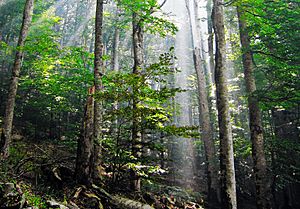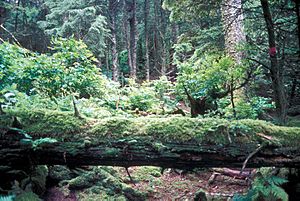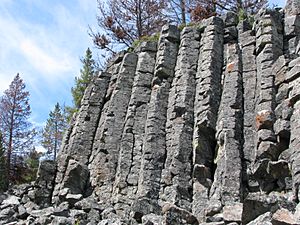Wilderness facts for kids

Wilderness or wildland describes a natural place on Earth. These are areas that humans have not changed very much. Think of them as the planet's last truly wild spots. They do not have roads, pipelines, or other big buildings.
You can find wilderness areas in many places. These include National Parks, National Forests, and special conservation areas. Even some parts of cities along rivers or gulches can be wild. These wild places are super important for many reasons. They help different species survive and keep our planet's biodiversity healthy. They also offer quiet places for people to relax and enjoy nature.
Wilderness is valued for many reasons. People find these areas important for their culture and spirit. Many writers believe wild places help human creativity. They also keep unique genetic traits safe. These areas provide homes for wild flora (plants) and fauna (animals). It would be very hard to create these homes in zoos or labs.
A place is considered wilderness if its natural processes happen without much human interference. This means that even if people have lived there in the past, it can still be wild. The key is that nature is still in charge.
The WILD Foundation says wilderness areas have two main features. They must be biologically healthy and legally protected. The World Conservation Union (IUCN) also classifies wilderness. They have categories for very strict nature preserves and general wilderness areas.
It is hard to find any place on Earth completely untouched by humans. This is because of past activities by native groups. Also, global changes like climate change affect everything. Even activities near wilderness areas, like stopping fires, can change them.
Many countries have laws to protect wilderness. This means that building and development are not allowed there. Countries like Australia, Canada, New Zealand, South Africa, and the United States have protected wilderness. People around the world are working hard to create new parks. They believe protecting these wild places is important for future generations.
Contents
Why Wilderness Matters
Protecting Nature's Balance
Wilderness areas are like giant natural laboratories. They help keep the planet's ecology in balance. These places are home to countless plants and animals. Many of these species cannot live anywhere else. Protecting wilderness helps save them from disappearing forever.
A Home for Wildlife
Imagine a place where animals can roam freely. Wilderness provides this space. It gives wildlife the room they need to find food and raise their young. Without these large, undisturbed areas, many animals would struggle to survive. This is especially true for animals that need a lot of space.
Keeping Our Planet Healthy
Wilderness areas play a big role in keeping our planet healthy. Forests in these areas help clean the air we breathe. Wetlands filter water, making it cleaner. These natural systems are vital for all life on Earth. They help regulate our climate and provide fresh water.
Where to Find Wilderness
National Parks and Forests
Many wilderness areas are found within National Parks. These parks are set aside by governments to protect nature. National Forests also contain large wild sections. These places are often open for people to visit and explore. You can enjoy hiking, camping, and wildlife watching there.
Protected Areas Worldwide
Many countries have special laws to protect wilderness. These laws stop new buildings or roads from being built. This helps keep the land wild and natural. These protected areas are found all over the world. They are important for global conservation efforts.
Wild Spots in Unexpected Places
You might be surprised where you can find wild areas. Even near cities, there can be small patches of wilderness. These might be along rivers or in undeveloped valleys. These smaller wild spots are also important. They provide a quick escape to nature for many people.
Protecting Wilderness for the Future
Laws and Conservation Efforts
Governments and groups work hard to protect wilderness. They create laws that prevent development in these areas. Conservation groups also buy land to keep it wild. These efforts help ensure that wilderness will be there for future generations.
Your Role in Protecting Wilderness
Even kids can help protect wilderness. You can learn about these special places. You can also support organizations that work to protect them. When you visit a wilderness area, remember to leave no trace. This means taking all your trash with you. It helps keep the area wild and clean for everyone.
Images for kids
-
Innoko Wilderness, Alaska United States in the summer.
-
El Toro Wilderness within the Caribbean National Forest in Puerto Rico.
-
Cook Lake in the Bridger Wilderness, Bridger-Teton National Forest, Wyoming, U.S.
-
The Great Swamp of New Jersey, was the first wilderness refuge in the United States. This is a winter scene.
-
Latir Peak Wilderness, seen from US-285 in New Mexico.
-
The Ahklun Mountains and the Togiak Wilderness within the Togiak National Wildlife Refuge in the U.S. state of Alaska.
-
Cedar Mountain Wilderness in northern Utah, United States.
See also
 In Spanish: Naturaleza salvaje para niños
In Spanish: Naturaleza salvaje para niños












